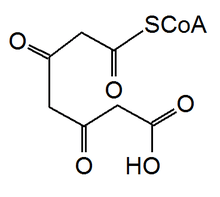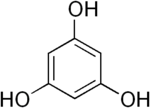Phloroglucinol
Phloroglucinol is an organic compound with the formula C6H3(OH)3. It is a colorless solid. It is used in the synthesis of pharmaceuticals and explosives. Phloroglucinol is one of three isomeric benzenetriols. The other two isomers are hydroxyquinol (1,2,4-benzenetriol) and pyrogallol (1,2,3-benzenetriol). Phloroglucinol, and its benzenetriol isomers, are still defined as "phenols" according to the IUPAC official nomenclature rules of chemical compounds. Many such monophenolics are often termed "polyphenols" by the cosmetic and parapharmaceutical industries, which does not match the scientifically accepted definition.
| |||
| Names | |||
|---|---|---|---|
| IUPAC name
Benzene-1,3,5-triol | |||
| Other names
phloroglucine, 1,3,5-benzenetriol, 1,3,5-trihydroxybenzene, or cyclohexane-1,3,5-trione | |||
| Identifiers | |||
3D model (JSmol) |
|||
| ChEBI | |||
| ChEMBL | |||
| ChemSpider | |||
| ECHA InfoCard | 100.003.284 | ||
| EC Number |
| ||
PubChem CID |
|||
| RTECS number |
| ||
| UNII | |||
CompTox Dashboard (EPA) |
|||
| |||
| |||
| Properties | |||
| C6H6O3 | |||
| Molar mass | 126.11 g/mol | ||
| Appearance | colorless to beige solid | ||
| Melting point | 219 °C (426 °F; 492 K) | ||
| 1 g/100 mL | |||
| Solubility | soluble in diethyl ether, ethanol, pyridine | ||
| Acidity (pKa) | 8.45 | ||
| -73.4·10−6 cm3/mol | |||
| Pharmacology | |||
| A03AX12 (WHO) | |||
| Hazards | |||
EU classification (DSD) (outdated) |
Harmful (Xn) | ||
| Lethal dose or concentration (LD, LC): | |||
LD50 (median dose) |
5 g/kg (rat, oral) | ||
Except where otherwise noted, data are given for materials in their standard state (at 25 °C [77 °F], 100 kPa). | |||
| Infobox references | |||
Synthesis and occurrence
In 1855, phloroglucinol was first prepared from phloretin by the Austrian chemist Heinrich Hlasiwetz (1825–1875).[1]
A modern synthesis of involves hydrolysis of benzene-1,3,5-triamine and its derivatives.[2] Representative is the following route from trinitrobenzene.[3]
The synthesis is noteworthy because ordinary aniline derivatives are unreactive toward hydroxide. Because the triaminobenzene also exists as its imine tautomer, it is susceptible to hydrolysis.
Reactions
Tautomerism and acid-base behavior
Phloroglucinol is a weak triprotic acid. The first two pKa's are 8.5 and 8.9.
As an enol, phloroglucinol in principle exists in equilibrium with keto tautomers. Evidence for this equilibrium is provided by the formation of the oxime:
- C6H3(OH)3 + 3 NH2OH → (CH2)3(C=NOH)3 + 3 H2O
But it behaves also like a benzenetriol as the three hydroxyl groups can be methylated to give 1,3,5-trimethoxybenzene.[3]
For the neutral compound, the keto tautomers are undetectable spectroscopically. Upon deprotonation, the keto tautomer predominates.[4]
Other reactions
From water, phloroglucinol crystallizes as the dihydrate, which has a melting point of 116–117 °C, but the anhydrous form melts at a much higher temperature, at 218–220 °C. It does not boil intact, but it does sublime.
The Hoesch reaction allows the synthesis of 1-(2,4,6-Trihydroxyphenyl)ethanone from phloroglucinol.[5]
Leptospermone can be synthesized from phloroglucinol by a reaction with isovaleroylnitrile in the presence of a zinc chloride catalyst.
Pentacarbon dioxide, described in 1988 by Günter Maier and others, can be obtained by pyrolysis of 1,3,5-cyclohexanetrione (phloroglucin).[6]
Phloroglucinol readily forms 5-aminoresorcinol (aka Phloramine) in aqueous ammonia at low temperatures.[7][8]
phloroglucinol & phloretic acid gives 30% yield of phloretin.
Natural occurrences
Phloroglucinol is also generally found in the flavonoid ring A substitution pattern. Indeed, it was originally prepared from phloretin, a compound isolated from fruit trees, using potassium hydroxide.[8] Additionally, the compound can be similarly prepared from glucosides, plant extracts and resins such as quercetin, catechin and phlobaphenes.
Phloroglucinols are secondary metabolites that occur naturally in certain plant species. It is also produced by brown algae and bacteria.
Acyl dervatives are present in the fronds of the coastal woodfern, Dryopteris arguta[9] or in Dryopteris crassirhizoma.[10] The anthelmintic activity of the root of Dryopteris filix-mas has been claimed to be due to flavaspidic acid, a phloroglucinol derivative.
Formylated phloroglucinol compounds (euglobals, macrocarpals and sideroxylonals) can be found in Eucalyptus species.[11] Hyperforin and adhyperforin are two phloroglucinols found in St John's wort. Humulone is a phloroglucinol derivative with three isoprenoid side-chains. Two side-chains are prenyl groups and one is an isovaleryl group. Humulone is a bitter-tasting chemical compound found in the resin of mature hops (Humulus lupulus).
Brown algae, such as Ecklonia stolonifera, Eisenia bicyclis[12] or species in the genus Zonaria,[13] produce phloroglucinol and phloroglucinol derivatives. Brown algae also produce a type of tannins known as phlorotannins.[14]
The bacterium Pseudomonas fluorescens produces phloroglucinol, phloroglucinol carboxylic acid and diacetylphloroglucinol.[15]
Biosynthesis

In Pseudomonas fluorescens, biosynthesis of phloroglucinol is performed with a type III polyketide synthase. The synthesis begins with the condensation of three malonyl-CoAs. Then decarboxylation followed by the cyclization of the activated 3,5-diketoheptanedioate product leads to the formation of phloroglucinol.[15]
The enzyme pyrogallol hydroxytransferase uses 1,2,3,5-tetrahydroxybenzene and 1,2,3-trihydroxybenzene (pyrogallol) to produce 1,3,5-trihydroxybenzene (phloroglucinol) and 1,2,3,5-tetrahydroxybenzene. It is found in the bacterium species Pelobacter acidigallici.
The enzyme phloroglucinol reductase uses dihydrophloroglucinol and NADP+ to produce phloroglucinol, NADPH, and H+. It is found in the bacterium species Eubacterium oxidoreducens.
The legume-root nodulating, microsymbiotic nitrogen-fixing bacterium species Bradyrhizobium japonicum is able to degrade catechin with formation of phloroglucinol carboxylic acid, further decarboxylated to phloroglucinol, which is dehydroxylated to resorcinol and hydroxyquinol.
Phloretin hydrolase uses phloretin and water to produce phloretate and phloroglucinol.
Health effects
It is also used as a treatment for gallstones, spasmodic pain and other related gastrointestinal disorders.[16][17] Whether for labour pains, abortion pains or benign gynaecologic pains, the results found are insufficient to promote the use of this drug in these indications.[18]
Phloroglucinols acylated derivatives have a fatty acid synthase inhibitory activity.[10]
ATC classification
It has the A03AX12 code in the A03AX Other drugs for functional bowel disorders section of the ATC code A03 Drugs for functional gastrointestinal disorders subgroup of the Anatomical Therapeutic Chemical Classification System. It also has the D02.755.684 code in the D02 Organic chemicals section of the Medical Subject Headings (MeSH) codes by the United States National Library of Medicine.
Applications
Phloroglucinol is mainly used as a coupling agent in printing. It links diazo dyes to give a fast black.
It is useful for the industrial synthesis of pharmaceuticals (Flopropione[19]) and explosives (TATB (2,4,6-triamino-1,3,5-trinitrobenzene), trinitrophloroglucinol,[20] 1,3,5-trinitrobenzene[21]).
Phloroglucinolysis is an analytical technique to study condensed tannins by means of depolymerisation. The reaction makes use of phloroglucinol as nucleophile. Phlobaphenes formation (tannins condensation and precipitation) can be minimized in using strong nucleophiles, such as phloroglucinol, during pine tannins extraction.[22]
Phloroglucinol is used in plant culture media. It demonstrates both cytokinin-like and auxin-like activity. Phloroglucinol increases shoot formation and somatic embryogenesis in several horticultural and grain crops. When added to rooting media together with auxin, phloroglucinol further stimulates rooting.[23]
Use in tests
Phloroglucinol is a reagent of the Tollens' test for pentoses. This test relies on reaction of the furfural with phloroglucinol to produce a colored compound with high molar absorptivity.[24]
A solution of hydrochloric acid and phloroglucinol is also used for the detection of lignin (Wiesner test). A brilliant red color develops, owing to the presence of coniferaldehyde groups in the lignin.[25] A similar test can be performed with tolonium chloride.
It is also part of Gunzburg reagent, an alcoholic solution of phloroglucinol and vanillin, for the qualitative detection of free hydrochloric acid in gastric juice.
References
- See:
- Hlasiwetz, Heinrich (1855). "Ueber das Phloretin" [On phloretin]. Annalen der Chemie und Pharmacie. 96 (1): 118–123. doi:10.1002/jlac.18550960115. On p. 120, Hlasiwetz named phloroglucin: "Die auffallendste Eigenschaft dieses Körpers ist, daſs er überaus süſs schmeckt, weſshalb er bis auf weiteres Phloroglucin genannt sein mag." (The most striking property of this substance is that it tastes extremely sweet, for which reason it may be named "phloroglucin" until further [information emerges].)
- Thorpe, Edward, ed., A Dictionary of Applied Chemistry (London, England: Longmans, Green, and Co., 1913), vol. 4, 183.
- H. T. Clarke and W. W. Hartman (1929). "Phloroglucinol". Org. Synth. 9: 74. doi:10.15227/orgsyn.009.0074.
- Fiege, H.; Voges, H. W.; Hamamoto, T.; Umemura, S.; Iwata, T.; Miki, H.; Fujita, Y.; Buysch, H. J.; Garbe, D.; Paulus, W. (2000). "Phenol Derivatives". Ullmann's Encyclopedia of Industrial Chemistry. doi:10.1002/14356007.a19_313. ISBN 978-3527306732.
- Martin Lohrie; Wilhelm Knoche (1993). "Dissociation and Keto-Enol Tautomerism of Phloroglucinol and its Anions in Aqueous Solution". J. Am. Chem. Soc. 115 (3): 3919–924. doi:10.1021/ja00056a016.
- Gulati, K. C.; Seth, S. R.; Venkataraman, K. (1935). "Phloroacetophenone". Organic Syntheses. 15: 70. doi:10.15227/orgsyn.015.0070.
- Maier, G.; Reisenauer, H. P.; Schäfer, U.; Balli, H. (1988). "C5O2 (1,2,3,4-Pentatetraene-1,5-dione), a New Oxide of Carbon". Angewandte Chemie International Edition. 27 (4): 566–568. doi:10.1002/anie.198805661.
- Gmelin, Leopold (1862). Watts, Henry (ed.). Hand-Book of Chemistry, Volume 15 (1st ed.). London: The Cavendish Society. Retrieved 26 December 2016.
- Roscoe, H.E.; Schorlemmer, C. (1893). A Treatise on Chemistry, Volume 3, Part 3 (1st ed.). New York: D Appleton and Company. pp. 193 & 253. Retrieved 26 December 2016.
- C. Michael Hogan (December 14, 2008). "Coastal Woodfern (Dryopteris arguta)". GlobalTwitcher. Archived from the original on 2011-07-11.CS1 maint: unfit url (link)
- Na, M.; Jang, J.; Min, B. S.; Lee, S. J.; Lee, M. S.; Kim, B. Y.; Oh, W. K.; Ahn, J. S. (2006). "Fatty acid synthase inhibitory activity of acylphloroglucinols isolated from Dryopteris crassirhizoma". Bioorganic & Medicinal Chemistry Letters. 16 (18): 4738–4742. doi:10.1016/j.bmcl.2006.07.018. PMID 16870425.
- Eschler, B. M.; Pass, D. M.; Willis, R.; Foley, W. J. (2000). "Distribution of foliar formylated phloroglucinol derivatives amongst Eucalyptus species". Biochemical Systematics and Ecology. 28 (9): 813–824. doi:10.1016/S0305-1978(99)00123-4. PMID 10913843.
- Okada, Y.; Ishimaru, A.; Suzuki, R.; Okuyama, T. (2004). "A New Phloroglucinol Derivative from the Brown AlgaEisenia bicyclis: Potential for the Effective Treatment of Diabetic Complications". Journal of Natural Products. 67 (1): 103–105. doi:10.1021/np030323j. PMID 14738398.
- Blackman, A. J.; Rogers, G. I.; Volkman, J. K. (1988). "Phloroglucinol Derivatives from Three Australian Marine Algae of the Genus Zonaria". Journal of Natural Products. 51: 158–160. doi:10.1021/np50055a027.
- Shibata, T.; Kawaguchi, S.; Hama, Y.; Inagaki, M.; Yamaguchi, K.; Nakamura, T. (2004). "Local and chemical distribution of phlorotannins in brown algae". Journal of Applied Phycology. 16 (4): 291. doi:10.1023/B:JAPH.0000047781.24993.0a.
- Achkar, J.; Xian, M.; Zhao, H.; Frost, J. W. (2005). "Biosynthesis of Phloroglucinol". Journal of the American Chemical Society. 127 (15): 5332–5333. doi:10.1021/ja042340g. PMID 15826166.
- "Phloroglucinol Summary Report" (PDF). EMEA. Archived from the original (PDF) on 10 July 2007. Retrieved 24 April 2009.
- Chassany, O.; Bonaz, B.; Bruley Des Varannes, S.; Bueno, L.; Cargill, G.; Coffin, B.; Ducrotté, P.; Grangé, V. (2007). "Acute exacerbation of pain in irritable bowel syndrome: Efficacy of phloroglucinol/trimethylphloroglucinol - a randomized, double-blind, placebo-controlled study". Alimentary Pharmacology & Therapeutics. 25 (9): 1115–1123. doi:10.1111/j.1365-2036.2007.03296.x. PMC 2683251. PMID 17439513.
- Clara B, Paul V, Denis P, Stéphanie M, Hélène VR, Rémy B (2020). "Efficacy of phloroglucinol for the treatment of pain of gynaecologic or obstetrical origin: a systematic review of literature of randomised controlled trials". Eur J Clin Pharmacol. doi:10.1007/s00228-019-02745-7.CS1 maint: uses authors parameter (link)
- "Intermediate Pharmaceutical Ingredients - Flopropione" (PDF). Univar Canada. Retrieved 24 April 2009.
- "Synthesis of trinitrophloroglucinol". The United States Patent and Trademark Office. 1984. Retrieved 24 April 2009.
- A facile two-step Synthesis of 1,3,5-trinitrobenzene. Bottaro Jeffrey C, Malhotra Ripudaman and Dodge Allen, Synthesis, 2004, no 4, pages 499-500, INIST:15629637
- Sealy-Fisher, V. J.; Pizzi, A. (1992). "Increased pine tannins extraction and wood adhesives development by phlobaphenes minimization". Holz Als Roh- und Werkstoff. 50 (5): 212. doi:10.1007/BF02663290.
- Teixeira da Silva, Jaime A.; Dobránszki, Judit; Ross, Silvia (2013-02-01). "Phloroglucinol in plant tissue culture". In Vitro Cellular & Developmental Biology - Plant. 49 (1): 1–16. doi:10.1007/s11627-013-9491-2. ISSN 1475-2689.
- Oshitna, K., and Tollens, B., Ueber Spectral-reactionen des Methylfurfurols. Ber. Dtsch. Chem. Ges. 34, 1425 (1901)
- Lignin production and detection in wood. John M. Harkin, U.S. Forest Service Research Note FPL-0148, November 1966 (article)


